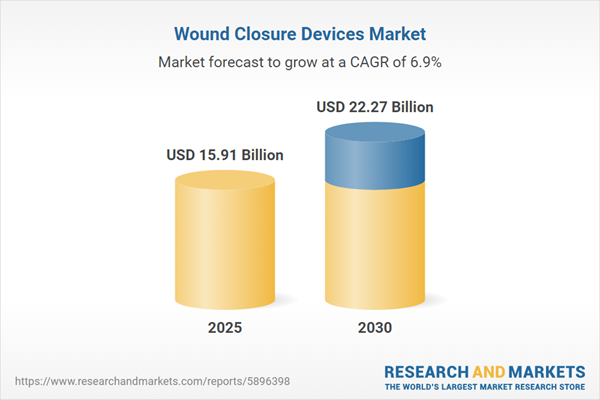Speak directly to the analyst to clarify any post sales queries you may have.
The wound closure devices market is rapidly evolving, shaped by technological advancements, shifting clinical needs, and an expanding landscape of patient care settings. Senior leaders face mounting pressure to navigate a dynamic environment that rewards innovation, operational flexibility, and precise strategic positioning.
Market Snapshot: Wound Closure Devices Market Size and Growth
The Wound Closure Devices Market grew from USD 14.91 billion in 2024 to USD 15.91 billion in 2025. It is expected to continue growing at a CAGR of 6.91%, reaching USD 22.27 billion by 2030. This robust trajectory signals consistent demand across hospitals, clinics, and home healthcare, propelled by adoption of advanced biomaterials and digital monitoring technologies. The market’s scalability provides both established manufacturers and new entrants with diverse avenues for expansion and revenue generation.
Scope & Segmentation: In-Depth Analysis to Inform Strategy
- Product Types: Adhesives and tissue sealants, closure strips and tapes, collagen-based sealants, cyanoacrylate adhesives, fibrin sealants, mechanical devices, tissue expanders, wound closure systems, manual staplers, powered staplers, absorbable sutures, non-absorbable sutures.
- Wound Types: Acute wounds (including surgical incisions and traumatic injuries) and chronic wounds (such as arterial, diabetic, pressure, and venous ulcers).
- Usability: Disposable and reusable wound closure devices.
- Application Areas: Cardiothoracic, cosmetic and plastic, dental and maxillofacial, emergency medicine and trauma, gastrointestinal and colorectal, general, neurosurgery, obstetrics and gynecology, ophthalmic, orthopedic, and vascular surgeries.
- Patient Groups: Adults, geriatrics, and pediatrics.
- End Users: Ambulatory surgical centers, home healthcare providers, hospitals, and trauma centers.
- Distribution Channels: Offline, online (through brand websites and eCommerce platforms).
- Geographic Regions: Americas (North America and Latin America), Europe, Middle East, Africa, and Asia-Pacific with specific country-level coverage including the United States, Canada, Germany, China, India, and more.
- Top Companies Analyzed: 3M Company, Advanced Medical Solutions Group plc, Smith+Nephew plc, Coloplast A/S, Medtronic plc, Stryker Corporation, Johnson & Johnson Services, Inc., and others.
- Advanced Technologies: Integration of biomaterials, automation, digital monitoring, powered stapling systems, AI-driven surgical platforms, and real-time tissue assessment tools.
Key Takeaways for Senior Decision-Makers
- Biomaterials integration and digital solutions are transforming wound closure, leading to less invasive procedures and enhanced patient experiences in multiple clinical environments.
- Value chain complexity requires agile navigation of regulatory trends, procurement models, and reimbursement policies for optimal commercial outcomes.
- Regional differences in clinical practices and reimbursement guidelines necessitate local adaptation of distribution, marketing, and stakeholder engagement strategies.
- Tissue adhesives, powered staplers, and tailored hemostatic agents are gaining traction, particularly when rapid closure and infection mitigation are critical priorities.
- Strategic collaborations and R&D diversification are driving next-generation innovations, positioning leaders to respond rapidly to evolving surgical demands.
- Customizing product portfolios to meet the needs of key end users—from hospitals to home care—improves workflow efficiency and overall patient recovery rates.
Tariff Impact on the Wound Closure Devices Market
Recent U.S. tariffs on imported components have prompted manufacturers to reshape global sourcing and supply strategies. Increased import duties on surgical tapes and adhesive polymers are influencing procurement costs and driving a shift toward domestic production options. Healthcare providers are adopting bundled purchasing and long-term contracts to manage pricing volatility and ensure continuity of supply, while manufacturers actively seek tariff exemptions and strategic alliances to protect margins.
Methodology & Data Sources
This market report leverages a combination of primary and secondary research. Insights were gathered from direct interviews with surgeons, regulatory experts, and procurement leaders, then validated through analysis of clinical journals, regulatory filings, and proprietary industry databases. Quantitative and qualitative assessment ensures reliable, current data supporting actionable strategic recommendations.
Why This Report Matters
- Gain a comprehensive understanding of core device categories, application contexts, and regional market nuances to inform product and investment strategies.
- Leverage robust data and segmentation insights for effective market entry, product development, and competitive benchmarking.
- Identify tactical responses to global supply chain fluctuations and regulatory shifts impacting the wound closure devices market.
Conclusion
The wound closure devices market presents substantial opportunities for growth through technology adoption, localization, and value-based strategies. Successful navigation demands a holistic approach, balancing innovation with operational adaptation and region-specific insights.
Additional Product Information:
- Purchase of this report includes 1 year online access with quarterly updates.
- This report can be updated on request. Please contact our Customer Experience team using the Ask a Question widget on our website.
Table of Contents
3. Executive Summary
4. Market Overview
7. Cumulative Impact of Artificial Intelligence 2025
Companies Mentioned
The companies profiled in this Wound Closure Devices market report include:- 3M Company
- Grünenthal GmbH
- Advanced Medical Solutions Group plc
- Alliqua BioMedical, Inc.
- AROA BIOSURGERY LIMITED
- Smith+Nephew plc
- AVITA Medical, Inc.
- B. Braun SE
- Baxter International Inc.
- Boston Scientific Corporation
- Chemence, Inc.
- Coloplast A/S
- Convatec Group Plc
- CooperSurgical, Inc.
- Corza Medical
- Integra LifeSciences Holdings Corporation
- DermaClip US, LLC
- Dukal, LLC
- Essity AB
- Johnson & Johnson Services, Inc.
- Futura Surgicare Pvt. Ltd.
- Healthium Medtech Limited
- Medtronic plc
- Meril Life Sciences Pvt. Ltd.
- Mölnlycke Health Care AB
- Stryker Corporation
- Teleflex Incorporated.
- Zimmer Biomet Holdings, Inc.
- Riverpoint Medical
Table Information
| Report Attribute | Details |
|---|---|
| No. of Pages | 195 |
| Published | November 2025 |
| Forecast Period | 2025 - 2030 |
| Estimated Market Value ( USD | $ 15.91 Billion |
| Forecasted Market Value ( USD | $ 22.27 Billion |
| Compound Annual Growth Rate | 6.9% |
| Regions Covered | Global |
| No. of Companies Mentioned | 30 |









